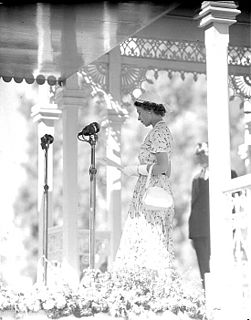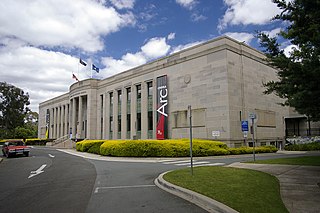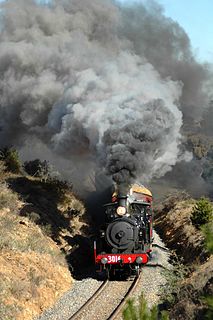
The Australian Capital Territory, known as the Federal Capital Territory (FCT) until 1938, is a landlocked federal territory of Australia containing the national capital Canberra and some surrounding townships. It is located in southeastern Australian mainland as an enclave completely within the state of New South Wales. Founded after Federation as the seat of government for the new nation, all important institutions of the Australian Government are headquartered in the territory.

Canberra is the capital city of Australia. Founded following the federation of the colonies of Australia as the seat of government for the new nation, it is Australia's largest inland city and the eighth-largest city overall. Unusual among Australian cities, it is an entirely planned city. The city is located at the northern end of the Australian Capital Territory at the northern tip of the Australian Alps, the country's highest mountain range. As of June 2020, Canberra's estimated population was 431,380.

The District of Belconnen is one of the original eighteen districts of the Australian Capital Territory (ACT), used in land administration. The district is subdivided into 27 divisions (suburbs), sections and blocks. The district of Belconnen is largely composed of Canberra suburbs.

The Canberra Nature Park is a series of thirty three separate protected areas in and around Canberra, Australian Capital Territory, ranging from bushland hills to lowland native grassland. Many of the areas have previously been cleared for grazing, but many are now being returned to native bushland through revegetation and rehabilitation programs.
Forrest is a suburb of Canberra, Australian Capital Territory, Australia. Forrest is named after Sir John Forrest, an explorer, legislator, federalist, premier of Western Australia, and one of the fathers of the Australian Constitution. Streets in Forrest are named after explorers and governors. According to the Australian Bureau of Statistics Forrest is the second most Socio-Economic advantaged location in Australia after the neighbouring suburb of Barton.

Barton is a suburb of Canberra, Australian Capital Territory, Australia. At the 2016 census, Barton had a population of 1,439 people.

Griffith is an early inner-south suburb of Canberra, Australian Capital Territory, Australia.
South Canberra, or the Inner South, is a central district of Canberra, the capital city of Australia.

Red Hill is a suburb of Canberra, Australian Capital Territory, Australia. The suburb is named after the northernmost hill of the ridge to the west of the suburb. The ridge is a reserve and managed as part of the Canberra Nature Park. The hill is an element of the central Canberra design axis.

The Hotel Canberra, also known as Hyatt Hotel Canberra, is a major hotel in the Australian national capital, Canberra. It is located in the suburb of Yarralumla, near Lake Burley Griffin and Parliament House. It was built to house politicians when the Federal Parliament moved to Canberra from Melbourne in 1927. It was constructed by the contractor John Howie between 1922-1925. Originally opened in 1924 as Hostel No. 1, in 1927 it became known as the Hotel Canberra.

Canberra Museum and Gallery is an art gallery and museum in Canberra, the capital of Australia. It is located on London Circuit, in Civic in the centre of the city. The gallery was opened on 13 February 1998.

Manuka is an area in the Inner South district of Canberra, Australia covering parts of the suburbs of Griffith and Forrest. Manuka Shops, Manuka Oval, Manuka Swimming Pool, and Manuka Circle take their name from the park in the area.

Royal tours of Australia by Australia's royal family have been taking place since 1867. Since then, there have been over fifty visits by a member of the Royal Family, though only six of those came before 1954. Elizabeth II is the only reigning monarch of Australia to have set foot on Australian soil; she first did so on 3 February 1954, when she was 27 years old. During her sixteen journeys the Queen has visited every Australian state and the two major territories.

Blundells Cottage is a heritage-listed six-roomed stone cottage located on the northern shore of Lake Burley Griffin, in Canberra, Australia. The cottage was built by George P. Campbell in about 1858 for his ploughman William Ginn on the original Molonglo River floodplain. Ginn lived there with his family until 1874 and then Flora and George Blundell moved in and remained there until about 1933. Flora was a midwife and George a bullock driver for Campbell. In 1913 the Duntroon estate was acquired by the Commonwealth of Australia to form part of the new Federal Capital Territory, although the Blundells continued to live there. Then Harry and Alice Oldfield moved to the cottage in 1933.

The Australian Institute of Anatomy was a natural history museum and medical research institute that was founded in 1931 and disbanded in 1985. The institute's heritage-listed building, located in Acton, Canberra, in the Australian Capital Territory, Australia, has been occupied by the National Film and Sound Archive (NFSA) since October 1984. The building was added to the Commonwealth Heritage List on 22 June 2004.

The Canberra Railway Museum is located at Kingston in the Australian Capital Territory (ACT), next to Canberra railway station on the Bombala railway line. Since May 2018, Canberra Railway Museum has been the trading name of a not-for-profit company, Capital Region Heritage Rail Limited, established to run the museum, while ACT Heritage Rail Holdings Limited is the company responsible for safeguarding the heritage assets of the museum.

The Hotel Kurrajong is a heritage-listed hotel located in the Canberra suburb of Barton, Australian Capital Territory, close to Parliament House and national institutions within the Parliamentary Triangle precinct. The Hotel has a strong association with Australia's political history, most notably as the residence of Prime Minister Ben Chifley throughout his parliamentary career, including his term in office from 1945-1949. In 1951, Chifley suffered a fatal heart attack in room 205 at the Hotel Kurrajong.

Energy produced in the Australian Capital Territory mainly consists of solar electricity. Electricity consumed in the Australian Capital Territory mainly comes from the national power grid through substations at Holt and Fyshwick. The ACT currently mandates that 100 percent of its electricity, will be supplied from renewable sources by 2020. The ACT has four solar farms capable of generating about 56.3 megawatts. From 1913 until the mid 1950s some power was produced from the Kingston Powerhouse, a thermal power station in Kingston.

Mugga Lane Solar Park is a photovoltaic solar power station at Hume in the Australian Capital Territory.
The Mugga Lane Zoo was a privately owned zoo located on Mugga Lane in the Australian capital city of Canberra. First opened in 1979 as the Canberra Wildlife Gardens, It was the first permanent zoo in the city, predating the National Zoo & Aquarium by over a decade. In 1981 the park was rebranded as the Mugga Lane Zoo, although the Canberra Wildlife Gardens name continued to be occasionally used until 1986. Before its closure in 2002, the zoo displayed over 116 different species of animals in its 9 ha (0.035 sq mi) park. Today, the now abandoned site remains a well known location in Canberra due to its popularity with urban explorers, and as a likely source of the feral peacocks often seen around South Canberra. According to the founder, Terry Thomas, the zoo was never financially successful, in part due to difficulties experienced attaining animal permits from the Department of the Capital Territory.

















